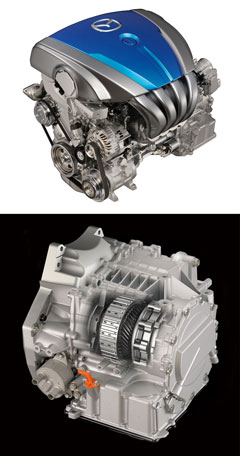Mazda goes SKY-high with new engines
BY RON HAMMERTON | 30th Sep 2009

To be showcased at next month’s Tokyo motor show, the four-cylinder 2.0-litre petrol SKY-G and 2.2-litre diesel SKY-D engines use latest fuel-injection designs, low-friction cylinder blocks and other technologies to cut fuel consumption by up to 15 and 20 per cent respectively.
They will go into production in Japan from 2011 and be phased in across a wide range of Mazda models for world-wide release, including Australia.
The engines will be mated with a new automatic transmission, called SKY-Drive, which Mazda says uses low-friction technologies to cut fuel use by a further five per cent while delivering the “feel” of a dual-clutch gearbox.
The powertrain line-up is part of Mazda’s previously announced ‘Sustainable Zoom-Zoom’ push to cut fuel consumption by 30 per cent by 2015 over 2008 levels – a project that also includes technologies such as idle-stop, light-weight construction and, ultimately, hybrid and perhaps hydrogen powertrains.
The SKY-G (for gasoline) engine and the SKY-Drive transmission will be shown at the Tokyo show in Mazda’s recycled Kiyora concept car that was originally revealed at the Paris motor show last year.

Mazda claims the combination of featherweight Kiyora body and new SKY-G powertrain can achieve 3.1L/100km fuel economy – 0.8L/100km better than Toyota’s hybrid Prius and less than half the official 8.4L/100km figure achieved by the current petrol 2.5-litre Mazda6.
First details of the new ‘SKY’ range of engines and automatic transmission were released this week by Mazda in a preview of its Tokyo offerings, but many of the specifics - including output figures - have been held back until media briefings in conjunction with the show.
However, Mazda Australia confirmed that the new powertrains will appear in Mazda cars in Australian showrooms at some point after the 2011 Japanese debut.
Public relations manager Steve Maciver said: “Yes, I can confirm they will be coming to Australia, in the not too distant future, but certainly not in the next year, but we are not talking five years away.
“There are plans for introduction world-wide.”Mr Maciver said he could not say which model would debut the new powertrains in Australia.
He confirmed that the SKY-D turbo-diesel engine would replace the near-new MZR-CD range of diesel engines released in the Mazda6 just last December.
Back then, Mazda claimed that the 136kW/400Nm 2.2-litre MZR-CD diesel made major performance and efficiency gains over the previous 2.0-litre unit.
The same engine has been earmarked for introduction alongside petrol variants in the Mazda3 from early next year and possibly the facelifted CX-7 out next month.
But before those models have even hit the streets, Mazda has announced that the new SKY-D engine will cut fuel consumption by a further 20 per cent while also reducing exhaust emissions and increasing performance.
Mazda says the 2.2-litre SKY-D engine can produce fuel economy and emissions equivalent to those the current Mazda2 in a Mazda6.
It says the improvement is achieved in part by a new cylinder block design which reduces the four-cylinder diesel engine’s mechanical friction to the level of a petrol engine.
“By optimising the pressure and temperature in the cylinders, the shape of combustion chambers, and the fuel injection rate, combustion begins at the best timing in terms of thermal efficiency,” Mazda says.
“Specifically, by employing piezo injectors, a two-stage turbocharger and other technologies, fuel economy becomes approximately 20 per cent better than the current 2.2-litre diesel engine.
“Mazda has achieved fuel economy equivalent to the current Mazda2 in a vehicle the size of a Mazda6.” Like the SKY-D, the SKY-G petrol engine series is said to benefit from a new block design that helps to cut friction.
“A direct fuel-injection system is employed due to the wide variety of spray profiles that are possible, enabling the maximum expansion ratio to be achieved," Mazda says.
“Specifically, fuel economy and torque are improved by approximately 15 per cent compared to Mazda’s current 2.0-litre engine.
“This was achieved by adopting next-generation fuel injectors and a highly functional variable valve timing mechanism.”The new SKY-Drive transmission appears to be a conventional torque converter-type unit, but with a “complete redesign that significantly reduces mechanical friction, a revised torque converter and clutch with minimised slip, and an optimised lock-up mechanism”.
Mazda says a rapid clutch action was achieved by “identifying the minimum amount of fluid necessary.”“This also helped to realise a direct feel similar to a dual-clutch transmission.”There was no word on the number of gears.
Mazda will also feature a hydrogen-powered rotary-engined version of its Premacy people-mover on its stand at the 41st Tokyo motor show, which opens to the media on October 21-22 before going public on October 24.